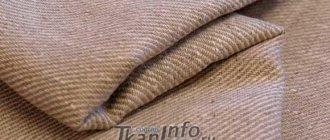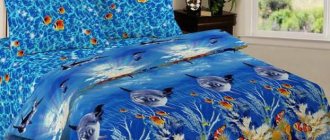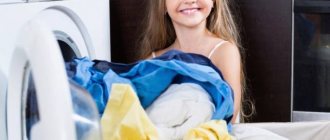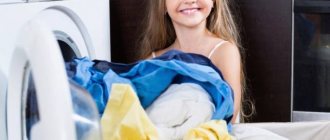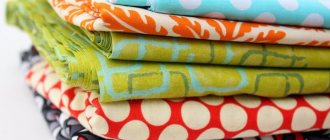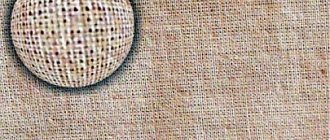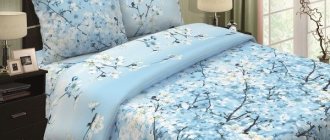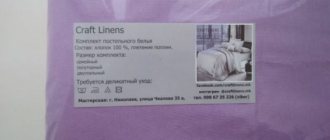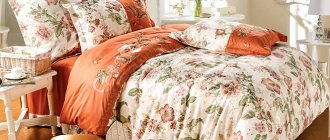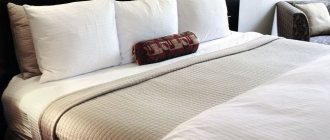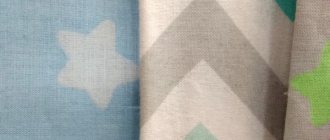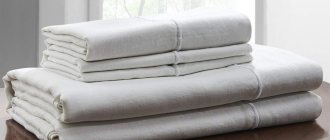Different materials have different densities, both surface and linear. Air permeability depends on this indicator, hygroscopicity to a lesser extent, and resistance to deformation and wear significantly depends. In turn, the density depends on the thickness of the threads, their number and the method of weaving.
Types of density
So, a distinction is made between linear and surface density. The first is defined as mass related to length (accordingly, measured in g/km). The second correlates with mass and is calculated in g/m2. When choosing bed linen, it is the last characteristic that is taken into account, and it is also indicated on the packaging of bed linen or a roll of fabric.
There is also an atypical density floating around on the Internet, the number of threads per 1 cm2. Strictly speaking, this is not the density of matter, but the density of weaving. What is the disadvantage of such a measurement? The fact is that the thicker the fibers, the fewer there are in a given area. 20 calico or silk fibers and 20 calico or terry fibers per one and the same square centimeter is a huge difference in density to the touch and in light, not to mention wear resistance. Nevertheless, we present the types of material on this basis.
Table 1. Weaving density
| Number of threads per 1 cm2 | Designation |
| 20—30 | Low |
| 35—40 | Medium low |
| 50—65 | Average |
| 65—80 | Medium-high |
| 85—120 | High |
| 130—280 | Very high |
Bed linen density chart
The assortment of modern textile stores will satisfy the most demanding tastes. Most bedding sets are based on cotton, but the type of thread weave and density allows manufacturers to create fabrics that differ significantly in their properties and appearance.
| Fabric type | Material | Weaving type | Density (g/m²) | Characteristic |
| Bike | Cotton with added wool | Twill | 360 | Soft, dense, wear-resistant, warm fabric. Used in the production of winter bedding sets. |
| Batiste | Long staple cotton varieties | Polotnyanoye | 20-30 | Thin, transparent fabric with low wear resistance. Suitable for festive bedding, such as wedding bedding. |
| Chintz | Cotton | Simple linen | 80-100 | Relatively durable, cheap, hypoallergenic fabric. |
| Poplin | Cotton | Linen made from threads of different thicknesses | 120 | Forms a small scar, retains color and shape well, and absorbs moisture. |
| Calico | According to Russian GOST 100% cotton, according to the specifications of China, Turkey and Pakistan, the presence of 15% polyester thread is allowed | Linen cross-shaped | 50-130 | Dense fabric that cannot be deformed. Absorbs moisture well, allowing the skin to breathe. Relatively cheap. |
| Satin | Double twisted cotton thread | Polotnyanoye | 85-130 | Smooth and shiny, does not form “pellets”. Durable. |
| Silk | Threads extracted from the cocoon of the silkworm | Mostly twill | 170-220 | Shiny, soft fabric |
| Linen | Linen | Calico | 170-200 | Dense, slightly rough fabric with good absorbent properties |
| Tencel | High quality wood pulp | Satin weave | 125 | Hypoallergenic fabric with bactericidal properties. Delicate, soft, relatively expensive |
Weaving methods
Fibers of the same linear mass are arranged in different ways in production. As a result, we get a huge variety of materials.
The main weaves used in bed linen:
- plain - the simplest alternation of longitudinal and transverse threads 1:1;
- satin - an arrangement in which the transverse (weft) threads extend to the front side, each of them overlaps 4-5 longitudinal threads (warp).
The most popular plain weave fabrics: calico, its variety ranfors (with a very high density), poplin, chintz. The latter is a very light fabric made of delicate thin fibers. Poplin is made by weaving a thinner warp and a thicker weft, resulting in a fine ribbed pattern and close interlocking of the fibers.
Satin weaving gives the material some looseness, which immediately classifies it as delicate. However, this achieves softness, smoothness, and a silky shine. People with sensitive skin always choose satin bedding.
Calico for bed linen
Calico has been used to make bed linen for several centuries. It is a relatively dense cotton fabric with a plain cross weave.
Many people believe that it contains exclusively natural fibers, but this is a misconception: modern fabric is often made using synthetic threads.
Standard Density
The technical conditions of the enterprise, as well as state standards, specify not only typical values of surface density, but also permissible deviations in the batch and roll (up to –5%). If the actual indicator differs from that specified in the documentation for the material, this is considered a defect.
So, what density is suitable for bedding? To find out, look at GOST 31307-2005. The range of indicators is not limited from above, but the minimum density should not be lower than 110 g/m2.
The same standard, as well as GOST 21790-93 and GOST 29298-2005, contain standards for resistance to wear, deformation, fading, etc. However, in none of these documents we will not find what density a particular type of fabric for bedding should have.
From these sources, from wear resistance tables, we obtain the following density standards:
- cotton fabrics - 110-150 g/m2;
- satin weave fabrics - 110-220, 220-250 and over 250 g/m2.
Important! If the declared density of the bedding set is less than 110 g/m2, refrain from purchasing. There will be no quality here.
Calico
The most common canvas on the market is each square. m which weighs from 110 to 145 g.
Table 2. Calico, depending on density
| Market name | Density, g/m2 |
| Light (light) | 110 |
| Standard | 125 |
| Comfort and luxury* | 120 |
| GOST | 145 |
Note. Lux is distinguished not by density, but by the thinness of the fibers and their strength. Thanks to special processing, this fabric is very light and delicate compared to other calicoes.
Poplin
Poplin is said to be a very dense fabric, but this is not entirely true. Thanks to the thin warp threads, it turns out to be quite light, its surface density is about 125 g/m2, plus or minus depending on the type.
At the same time, for 1 sq. cm there are 85-120 threads, and this is a high figure. The fibers are closely adjacent to each other, which makes poplin impervious to thin down feathers - therefore this material is better than others for lower pillowcases and bedspreads.
Satin
This fabric is most often made from silk/viscose, cotton or a mixture of both. The shelves usually receive material with a density of 125-220 g/m2. Expensive sets are made with a jacquard pattern (for example, satin stripe).
Advice! Satin requires careful washing, so it makes no sense to put it on a newborn’s bed, which must be changed frequently and disinfected with hot water.
Reviews
Elena:
I was given a set of bed linen from Shuya. The packaging said “Shuiskaya calico”. I have been using bed linen made from Shuya calico for about five years now, which I am very pleased with: I wash it at 40 degrees and iron it slightly damp. The color does not fade or shrink. That's why I was happy about the gift. But it turns out that it’s too early. The donated underwear had nothing in common with mine. Even at first glance it was thinner, not so dense. The fade had not yet been washed: in the morning the whole body was blue! I threw it away and didn't even wash it. I was very upset. I think that it was a counterfeit of Shuya calico, because Shuikaya has always been distinguished by its quality.
Oksana:
All my bed linen is made of calico. I believe that there is no better fabric for it. Very practical, indestructible, and reasonable in price. For my children and grandchildren I bought diapers and vests made of calico: the colors are cheerful and the fabric is natural. I also have curtains in my dacha that are all made of calico: they don’t fade, the colors are bright.
Lilya:
I sew bed linen myself, both for myself and as a gift. I sew from calico. I like Turkish and Pakistani the most. It is very easy to work with, and the products are durable. Good, although a little heavier, Shuya calico. When working with it, you need to take into account that after washing this fabric can shrink by 5%.
Raw materials
The durability, comfort and hygiene of bed linen is affected not only by density, but also by what the material is made of. First of all, the composition. Natural fabrics or with a small percentage of synthetics are preferred. Synthetic or artificial (for example, viscose) fabrics are also acceptable, but provided that their hygienic indicators comply with GOST 31307-2005.
Durability also depends on the twist of the threads. The stronger it is, the denser it is, but also the tougher it is. Loosely twisted threads are soft, slightly fleecy, very pleasant to the body, but they are not wear-resistant and are often covered with pellets.
Finally, the length of the fibers. For the highest quality fabrics, long fibers are taken, which form a uniform, smooth surface. The cheaper the fabric, the shorter its fibers, which are connected by knots, and they are felt as roughness. This material is less pleasant to the touch and worse to use.
Advantages and disadvantages
The use of calico to create bed linen is explained by the presence of a large number of advantages. These include:
- Naturalness. The main component of the composition is cotton. Sometimes synthetic fibers are added to it, but in small quantities.
- Hygiene. Contamination from this material is easily removed using any detergent.
- High strength. The fabric lasts for many years without changing its appearance.
- Ease of care. Linen made from calico is easy to iron with a simple iron (if it has not been too dry).
- Safety. Static electricity does not accumulate in matter. It is not suitable for the life and reproduction of pathological microorganisms.
- Preserving the brightness of the picture. The material does not fade in the sun, which preserves the appearance of the product for a long time.
- Practicality. This linen is easy to care for. These kits are characterized by wear resistance.
- Hypoallergenic. The natural composition guarantees the absence of allergic reactions.
- Unpretentiousness. Any detergent is suitable for washing. The aggressive action of washing powder does not harm the fabric or design.
- Preservation of shape. When washing clothes, shrinkage does not occur, and when used, the material does not wrinkle or deform.
- Comfort when using. These products are convenient to use at any time of the year. They absorb sweat in hot weather and provide warmth in winter.
- Affordable price. Calico linen is purchased and used by people with any income.
This material has few disadvantages. This:
- Formation of pellets. With prolonged use, seals appear in the threads, which leads to such a defect. This is especially true for low quality material.
- Difficulty ironing dry clothes. But this drawback is neutralized due to the presence of steamers in modern irons.
Calico has more advantages. By choosing high-quality fabric, you can avoid the problem of pilling - there are no seals in it, and with proper care, the original appearance of the product will remain for a long time.
Which underwear to choose
You shouldn’t chase what’s expensive or what’s cheap. The best option is to choose a set in accordance with your home environment.
For a newborn's bedding, choose high density and calico or poplin weave; they are most resistant to repeated washing and ironing at high temperatures. If you and your older children have high skin sensitivity, most likely the new family member will have it too. Therefore, evaluate the smoothness of the linen to the touch, or estimate the price (materials made from long fibers are more expensive). In any case, discard chintz - it will quickly become unusable.
Select bedding for children and teenagers, as well as for adults, depending on the characteristics of the body and habits, as well as the number of replacement sets (the fewer there are, the more durable the fabric should be, respectively, the higher the density is recommended).
If a child or adult sleeps restlessly or tosses and turns a lot in bed, you should take care to securely fasten the sheets (with an elastic band, for example) and choose denser models that are not as easy to gather into folds and creases as thin ones.
If, for reasons of economy or for the sake of an interesting print, you buy thin bed linen, below 120 g/m2, be prepared in advance for careful care. Washing - at 30-40 degrees, drying flat, ironing on medium heat. Such a set will last longer if it has two or three sets per change. But even then, thin material will deform, fade, become covered in pellets, or all of this at once much faster than its dense counterparts.
The density of fabric for bed linen should be at least 110 g/m2, and the optimal figure would be 120 grams per square meter. meter. The smoothness of the material depends not only on the density, but also on the weaving method (the smoothest is satin) and the quality of the raw materials (the longer the fibers in the thread, the stronger and smoother the material). When making a choice, be guided by the manufacturer’s markings, as well as your own tactile sensations. Beautiful and comfortable bed linen is one of the important attributes of comfort and sweet sleep.
Description
Calico is a fabric made from cotton. It is also included in satin, poplin, and chintz. These and other types of materials are similar to each other because they are classified as cotton products. They differ in the way the threads are interwoven, density and the presence of additional components in the composition.
When making calico, synthetic fibers are added to cotton. Very few of them are used, so the fabric is natural. The threads in it are intertwined crosswise. The material has a smooth surface and matte finish. The front and back sides are the same. Thanks to its natural composition, calico is safe for health and does not cause allergies. Therefore, it is widely used for sewing clothes for adults and children and for bed linen.
The material is practical. It is easy to wash and iron, and products made from it will last a long time. There are different types of calico, which differ in quality. It depends on the density of the material. The higher the density, the longer the fabric lasts. This indicator is the weight of the threads used to make a square meter of material.
Important! According to GOST, calico 145 g/sq.m is considered high quality. It is highly durable. At home, you can use medium-density fabric - 125 g/sq.m. If the product is made of fabric with a lower density, it will quickly become unusable.
Average prices, nuances of care
Calico is very easy to care for . You may ask, how to wash calico and at what temperature? It is easy to wash and iron. It is almost not subject to shedding and allows the use of a wide variety of washing powders and gels. But to extend the service life of products made from this fabric, we can recommend the following rules:
- It is better to wash at a temperature no higher than 40 degrees , although bleached laundry can be safely boiled;
- wash separately from other fabrics to prevent deterioration of its consumer properties;
- squeeze in the drum of the washing machine, not exceeding 800 revolutions per second, otherwise after the end of the washing process it will be much more difficult to iron the fabric;
- after spinning, it is useful to shake the material to restore the weave structure and prevent an increase in rigidity;
- calico absorbs odors and moisture, so it is preferable to dry it in the fresh air (balcony or loggia facing the inner side of the yard;
- before using the products for the first time, it is necessary to wash them slightly, since this will make the linen softer and simply more hygienic;
- If, when washing a dyed product, turn it inside out before placing it in the drum of the washing machine, this will allow you to enjoy the bright and colorful shades of calico materials even longer.
For a long time, the price per square meter of this natural material in our stores did not change and ranged from 30 to 50 rubles per roll (without coloring) .
The price of bed linen made from calico weave fabrics varied widely and depended on the manufacturer, color and other nuances.
Nowadays, the range of prices is also wide, but on average for dress types, as well as for bedding, from 100 rubles per square meter. Because of its tried and tested properties, calico is widely deservedly popular .
